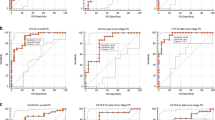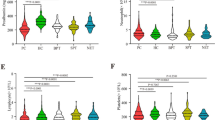Abstract
Background
Timely, accurate diagnosis of pancreatic adenocarcinoma (PA) is hampered by the lack of effective circulating biomarkers. No single test has emerged that improves upon the commonly used biomarker cancer antigen 19–9 (CA 19–9) to discriminate PA from benign conditions effectively. The goals of this study were to validate two acute-phase proteins, haptoglobin and serum amyloid A (SAA), as biomarkers for PA and determine if the combination of haptoglobin, SAA, and CA 19–9 would improve PA diagnosis over CA 19–9 alone.
Methods
Levels of haptoglobin, SAA, and CA 19–9 were measured in pretreatment sera from 75 PA patients, 32 patients with chronic pancreatitis, 42 patients with other benign pancreatic disease or biliary stricture, and 150 healthy control subjects by enzyme-linked immunosorbent assay or colorimetric binding assay. Relative levels of haptoglobin or SAA were compared between groups using analysis of variance. The diagnostic accuracy of serum haptoglobin and SAA levels were investigated using receiver operating characteristics (ROC) analysis. Using classification tree analysis, an algorithm was developed that used haptoglobin, SAA, and CA 19–9 in a diagnostic screening panel.
Results
Both haptoglobin and SAA were significantly elevated in sera from PA patients compared to healthy control subjects (p < 0.0001) and patients with chronic pancreatitis (p = 0.01). Haptoglobin was significantly elevated in sera from PA patients relative to patients with other benign diseases (p = 0.0015), whereas SAA fell short of significance in the same comparison (p = 0.0508). ROC analysis indicated that haptoglobin [area under the curve (AUC) = 0.792] was a better diagnostic marker than SAA (AUC = 0.691) over multiple threshold cutoffs. Using specific cutoffs that minimized overall misclassification, haptoglobin yielded a sensitivity of 82.7% and a specificity of 71.1%, and SAA yielded a sensitivity of 34.7% and a specificity of 90.2% when discriminating PA cases from all non-PA controls. In the same sample set, CA 19–9 yielded a sensitivity of 77.3% and a specificity of 91.1%. Combining data from haptoglobin, SAA, and CA 19–9 in a diagnostic screening panel improved the overall accuracy when compared to CA 19–9 alone, yielding a sensitivity of 81.3% and a specificity of 95.5%.
Conclusions
These data demonstrate that haptoglobin and SAA are useful for discriminating PA from benign conditions as well as healthy controls when used in a diagnostic screening panel. This study supports the use of combined biomarkers for improved accuracy in the diagnosis of PA.



Similar content being viewed by others
References
Jemal A, Siegel R, Ward E et al (2008) Cancer statistics, 2008. CA Cancer J Clin 58:71–96
Glenn J, Steinberg WM, Kurtzman SH et al (1988) Evaluation of the utility of a radioimmunoassay for serum CA 19–9 levels in patients before and after treatment of carcinoma of the pancreas. J Clin Oncol 6:462–468
Ritts RE, Pitt HA (1998) CA 19–9 in pancreatic cancer. Surg Oncol Clin N Am 7:93–101
Goonetilleke KS, Siriwardena AK (2007) Systematic review of carbohydrate antigen (CA 19–9) as a biochemical marker in the diagnosis of pancreatic cancer. Eur J Surg Oncol 33:266–270
Cooperman A (2001) The pancreas revisited. II. Benign and malignanat tumors—an interdisciplinary approach: pancreatic cancer. Surg Clin 81:3
Peterli R, Meyer-Wyss B, Herzog U et al (1999) CA19–9 has no value as a tumor marker in obstructive jaundice. Schweiz Med Wochenschr 129:77–79
Gold DV, Modrak DE, Ying Z et al (2006) New MUC1 serum immunoassay differentiates pancreatic cancer from pancreatitis. J Clin Oncol 24:252–258
Grote T, Logsdon CD (2007) Progress on molecular markers of pancreatic cancer. Curr Opin Gastroenterol 23:508–514
Ibis M, Koklu S, Yilmaz FM et al (2007) Serum adenosine deaminase levels in pancreatic diseases. Pancreatology 7:526–530
Koopmann J, Fedarko NS, Jain A et al (2004) Evaluation of osteopontin as biomarker for pancreatic adenocarcinoma. Cancer Epidemiol Biomarkers Prev 13:487–491
Koopmann J, Rosenzweig CN, Zhang Z et al (2006) Serum markers in patients with resectable pancreatic adenocarcinoma: macrophage inhibitory cytokine 1 versus CA19–9. Clin Cancer Res 12:442–446
Kuhlmann KF, van Till JW, Boermeester MA et al (2007) Evaluation of matrix metalloproteinase 7 in plasma and pancreatic juice as a biomarker for pancreatic cancer. Cancer Epidemiol Biomarkers Prev 16:886–891
Melle C, Ernst G, Escher N et al (2007) Protein profiling of microdissected pancreas carcinoma and identification of HSP27 as a potential serum marker. Clin Chem 53:629–635
Rosty C, Christa L, Kuzdzal S et al (2002) Identification of hepatocarcinoma-intestine-pancreas/pancreatitis-associated protein I as a biomarker for pancreatic ductal adenocarcinoma by protein biochip technology. Cancer Res 62:1868–1875
Simeone DM, Ji B, Banerjee M et al (2007) CEACAM1, a novel serum biomarker for pancreatic cancer. Pancreas 34:436–443
Zhou W, Sokoll LJ, Bruzek DJ et al (1998) Identifying markers for pancreatic cancer by gene expression analysis. Cancer Epidemiol Biomarkers Prev 7:109–112
Bharti A, Ma PC, Maulik G et al (2004) Haptoglobin alpha-subunit and hepatocyte growth factor can potentially serve as serum tumor biomarkers in small cell lung cancer. Anticancer Res 24:1031–1038
Biran H, Friedman N, Neumann L et al (1986) Serum amyloid A (SAA) variations in patients with cancer: correlation with disease activity, stage, primary site, and prognosis. J Clin Pathol 39:794–797
Chan DC, Chen CJ, Chu HC et al (2007) Evaluation of serum amyloid A as a biomarker for gastric cancer. Ann Surg Oncol 14:84–93
Diamandis EP (2004) Identification of serum amyloid A protein as a potentially useful biomarker for nasopharyngeal carcinoma [letter]. Clin Cancer Res 10:5293. Reply. Clin Cancer Res 10:5293–5294
Glojnaric I, Casl MT, Simic D et al (2001) Serum amyloid A protein (SAA) in colorectal carcinoma. Clin Chem Lab Med 39:129–133
Howard BA, Wang MZ, Campa MJ et al (2003) Identification and validation of a potential lung cancer serum biomarker detected by matrix-assisted laser desorption/ionization-time of flight spectra analysis. Proteomics 3:1720–1724
Khan N, Cromer CJ, Campa M et al (2004) Clinical utility of serum amyloid A and macrophage migration inhibitory factor as serum biomarkers for the detection of nonsmall cell lung carcinoma. Cancer 101:379–384
Tolson J, Bogumil R, Brunst E et al (2004) Serum protein profiling by SELDI mass spectrometry: detection of multiple variants of serum amyloid alpha in renal cancer patients. Lab Invest 84:845–856
Ye B, Cramer DW, Skates SJ et al (2003) Haptoglobin-alpha subunit as potential serum biomarker in ovarian cancer: identification and characterization using proteomic profiling and mass spectrometry. Clin Cancer Res 9:2904–2911
Deng R, Lu Z, Chen Y et al (2007) Plasma proteomic analysis of pancreatic cancer by 2-dimensional gel electrophoresis. Pancreas 34:310–317
Koomen JM, Shih LN, Coombes KR et al (2005) Plasma protein profiling for diagnosis of pancreatic cancer reveals the presence of host response proteins. Clin Cancer Res 11:1110–1118
Sun ZL, Zhu Y, Wang FQ et al (2007) Serum proteomic-based analysis of pancreatic carcinoma for the identification of potential cancer biomarkers. Biochim Biophys Acta 1774:764–771
Yokoi K, Shih LC, Kobayashi R et al (2005) Serum amyloid A as a tumor marker in sera of nude mice with orthotopic human pancreatic cancer and in plasma of patients with pancreatic cancer. Int J Oncol 27:1361–1369
Dobryszycka W (1997) Biological functions of haptoglobin—new pieces to an old puzzle. Eur J Clin Chem Clin Biochem 35:647–654
Oshiro S, Yajima Y, Kawamura K et al (1992) Catabolism of hemoglobin-haptoglobin complex in microsome subfractions. Chem Pharm Bull (Tokyo) 40:1847–1851
Cid MC, Grant DS, Hoffman GS et al (1993) Identification of haptoglobin as an angiogenic factor in sera from patients with systemic vasculitis. J Clin Invest 91:977–985
Gutteridge JM (1987) The antioxidant activity of haptoglobin towards haemoglobin-stimulated lipid peroxidation. Biochim Biophys Acta 917:219–223
De Kleijn DP, Smeets MB, Kemmeren PP et al (2002) Acute-phase protein haptoglobin is a cell migration factor involved in arterial restructuring. FASEB J 16:1123–1125
Uhlar CM, Whitehead AS (1999) Serum amyloid A, the major vertebrate acute-phase reactant. Eur J Biochem 265:501–523
Kaneta Y, Kagami Y, Tsunoda T et al (2003) Genome-wide analysis of gene-expression profiles in chronic myeloid leukemia cells using a cDNA microarray. Int J Oncol 23:681–691
Nishie A, Masuda K, Otsubo M et al (2001) High expression of the Cap43 gene in infiltrating macrophages of human renal cell carcinomas. Clin Cancer Res 7:2145–2151
Smeets MB, Fontijn J, Kavelaars A et al (2003) The acute phase protein haptoglobin is locally expressed in arthritic and oncological tissues. Int J Exp Pathol 84:69–74
Acknowledgments
This work was supported in part by research grants from the National Institutes of Health (R03 CA115225 to S.J.M. and P30CA042014 to the Huntsman Cancer Institute for support of core facilities), grants from the Huntsman Cancer Institute Pancreas Cancer Research Program, and through support from the Huntsman Cancer Foundation.
Author information
Authors and Affiliations
Corresponding author
Rights and permissions
About this article
Cite this article
Firpo, M.A., Gay, D.Z., Granger, S.R. et al. Improved Diagnosis of Pancreatic Adenocarcinoma Using Haptoglobin and Serum Amyloid A in a Panel Screen. World J Surg 33, 716–722 (2009). https://doi.org/10.1007/s00268-008-9853-9
Published:
Issue Date:
DOI: https://doi.org/10.1007/s00268-008-9853-9




